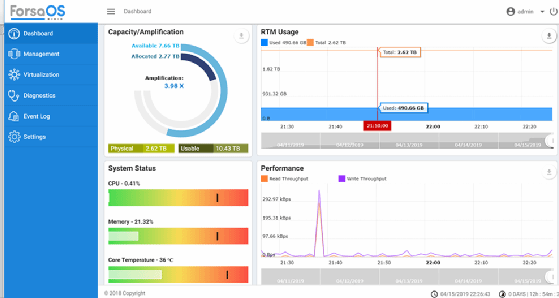
Warakorn - Fotolia
Formulus Black software stores data in persistent memory
Formulus Black has resurrected Symbolic IO technology to store data from database and analytics workloads in ultrafast system memory without changing the application code.
Persistent memory is one of the hottest topics in the data storage industry, and startup Formulus Black has launched a new Linux-based software stack designed to use it.
Formulus Black's ForsaOS can enable enterprises and cloud providers with latency-sensitive workloads, such as database and analytics programs, to keep all of their data in ultrafast server memory and forgo slower peripheral storage devices.
"In our environment, everything runs in the memory channel," said Wayne Rickard, chief marketing and strategy officer at Formulus Black. "Storage is memory. Memory is storage."
The design goal of ForsaOS is to remove the need for customers to modify software or pay a premium for applications such as SAP HANA to take advantage of in-memory architecture. ForsaOS abstracts the data plane to enable any workload that can run in a Kernel-based virtual machine to operate entirely in system memory without changes to the application code. Formulus Black modified the Ubuntu Linux kernel to provide a direct path to logical extended memory, which acts as a virtual disk for the VMs.
Data reduction technology
The ForsaOS software stack uses patented Formulus Bit Marker (FbM) algorithms to eliminate redundant data, so it can pack more data into the server's main memory. Rickard said ForsaOS typically reduces a data set stored in DIMMs by three to four times.
The Formulus Black software stack uses intellectual property from Symbolic IO, which sold Intensified RAM Intelligent Server appliances. Symbolic IO's board of directors brought in new management after the startup's founder and CEO was arrested in 2017 in connection with a domestic assault incident.
Formulus Black acquired Symbolic IO's intellectual property and restructured as a software company led by entrepreneur Carr Bettis. CTO Rob Peglar stayed on with the new company, and former Symbolic IO board member Steve Sicola is now a Formulus Black senior fellow.

Works with Optane DC persistent memory
Rickard said dynamic RAM (DRAM) is the preferable memory choice for Formulus Black because it works fastest with performance- and latency-sensitive workloads. But the ForsaOS software stack could also support emerging options such as magnetoresistive RAM (MRAM) and Intel's new Optane DC persistent memory, which uses 3D XPoint technology.
"If it's in the memory bus, it'll work with us," Rickard said. "We're excited about all these new classes of persistent memory. I suspect that as they become more mainstream and cost-effective, they will become our primary focus. For now, we provide all those benefits on DRAM."
Unlike non-volatile 3D XPoint and MRAM, DRAM requires a continuous power supply to retain data. But Rickard said that volatile DRAM is "effectively persistent" because servers don't usually lose power in modern data centers thanks to redundant rails of power from public utilities, uninterruptible power supply (UPS) devices and generators.
Formulus Black also developed the Blink technology, which can capture FbMs in real time and move a full system image from DRAM directly to external flash SSDs in the event of a power failure or planned shutdown for maintenance, just as a non-volatile DIMM would, Rickard said.
George Crump, president and founder of Storage Switzerland, said, as an "old storage guy," he gets nervous about memory losing power and potentially losing data. He advised ForsaOS customers to trigger periodic blinks to ensure a level of redundancy. Crump added that UPS technology can be prone to false reports.
"There's nothing here that makes me even more nervous than, say, implementing an NVMe fabric. But I would take precautions," Crump said. "It clearly is RAM, so I'd make sure I have a really good UPS that's reliable and would warn me if my battery is dying.
"And I would make sure I understood exactly how Blink worked, how often I could execute it and what the performance impact is if I blinked every 15 seconds or whatever," he said. "And I would want to determine, if I did lose RAM, what the ramifications are. If I lost power and 15 seconds later I can be back to where I was, it's probably not that big of a deal. But if it takes me three hours to rebuild whatever I had, that's a bigger challenge. "
Target use cases
Formulus Black plans to target hyper-converged infrastructure, high-performance computing and public cloud use cases in vertical industries, such as financial services, automotive, telecommunications, energy, education and healthcare. The company has tested ForsaOS with applications such as SQL Server, PostgreSQL, Hadoop, Greenplum and custom analytics programs, Rickard said.
"It's only going to fit, at least initially, for high-performance workloads where people want to put all of the application and all the data that it's processing in memory," said Marc Staimer, president of Dragon Slayer Consulting. "There's a reason why databases have gone to all memory. But the problem with going to all memory is you've got to make sure the data is also written to non-volatile storage of some type. And you have to have enough memory to do this -- and memory's expensive."
Staimer said Formulus Black's ability to amplify memory should help to reduce costs in comparison to alternatives that often require more hardware, at great expense, to achieve similar performance.
ForsaOS pricing
Pricing for ForsaOS is $5,000 to $8,000 per server socket in systems using Intel's Broadwell, Haswell or Skylake Xeon scalable processors.
The Formulus Black software stack requires at least 365 GB of memory to run, and the maximum supported memory configuration is about 3 TB in a two-socket server using Intel Skylake Xeon processors. Rickard said the current product only works in a two-socket server, but the next ForsaOS release will support clustering with an NVMe over Fabrics interconnect for low latency between the nodes.
So far, the only hardware partner to validate the ForsaOS configuration is AIC. But Rickard said Formulus Black and various integration partners have verified that the software works on commodity servers from major OEMs, such as Dell EMC, Hewlett Packard Enterprise, IBM and Supermicro.








